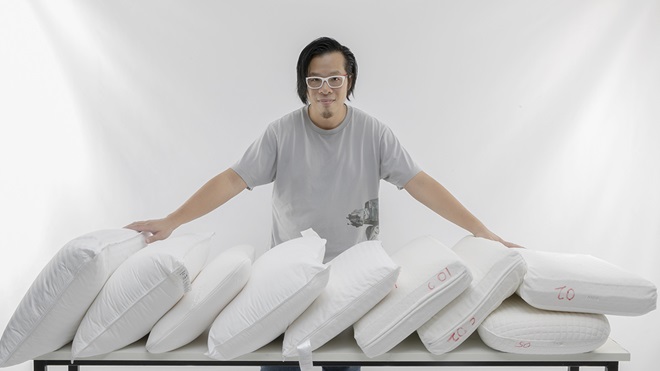The power of pillows is not to be underestimated. A good pillow can help you bounce out of bed refreshed, but a bad pillow can ruin your day before it's even begun, leaving you with sore shoulders, a cricked neck and the feeling that you got up on the wrong side of the bed.
But pillows aren't forever: even if you think you've found The One, you need to accept that it'll never be a long-term relationship (or if it is, it's pretty unhealthy!).
Eventually the honeymoon period will pass and you'll start dreaming about new, perky pillows that are unsullied by drool stains and sweat marks.
So whether you're planning a big bedroom refresh for the new year or shopping the sales for a bargain, here are some good reasons why you might want to give your old pillows the flick.
1. It doesn't pass the fold test
If you're not sure if your pillow is past its use-by date, our experts recommend this simple DIY test:
- Put your pillow on a flat surface and fold it in half.
- Hold it down for 30 seconds to a minute.
- Let go. If your pillow bounces back into its original shape, then your pillow is still good.
- If it doesn't spring back, then it's probably time to buy a new one.
We recommend testing approximately every six months to make sure your pillow is in tip top shape.

Does your pillow need replacing? Try this simple test to find out.
2. The filling is at the end of its lifespan
Different pillow materials deteriorate at different rates, so depending on what your pillow is filled with, you might need to replace it more often.
- Memory foam: 5–10+ years
- Latex: 5–10+ years
- Feather and down: 5–10+ years
- Polyester: 6 months to 2 years
- Cotton and wool: 3–5 years
3. It's past its use-by date (literally)
Some pillows come stamped with a recommended use-by date. Pillow manufacturer Tontine started this trend in 2010 when it started stamping its pillows with a two-year replacement date.
The cynical among us might think that it's a clever marketing ploy – after all, just how dirty can a pillow get in two years? But if nothing else it's a good reminder to check that your pillow isn't past its prime.
A pillow use-by date definitely doesn't need to be adhered to as stringently as a food use-by date, but considering that you spend eight hours drooling, sweating and shedding oils from your skin and hair into it each night, it's not something you want to hold onto for too long.
How is a use-by date decided?
We previously asked John Cotton (the company that owns Tontine) how it came up with a specific use-by date, but it no longer had the data. It implied it had data on how much dead skin, dust, sweat and other organic material accumulates on pillows (and other bedding).
The company told us its consumer research indicated that most people were keeping pillows for roughly seven years, but it recommended replacing pillows within two to three years of first use.
4. You're waking up in pain
Started waking up with a sore neck every morning? There are a few potential causes: poor posture, 'tech neck', or just ageing. But if you think your pillow might be the culprit, it could be time to hit the shops for a new one.
Whether you're a back or side sleeper, your pillow should support your head and neck so they're in a neutral or 'midline' position.
If you find you're having to fold your pillow in half just to get the comfort you used to from your pillow, it's probably on its last legs.
5. It's out of shape
Look, we all change shape as we age, and it's no different for pillows. But while you're just as loveable no matter what shape you are, the same can't be said for your pillow.
If your pillow is getting lumpy, is sagging, or has lost its firmness, there's no amount of shaking, fluffing or pummelling that'll fix it.
It can be hard to part with your favourite pillow, but sometimes you just need to admit that they've changed and move on with your life (and a new pillow).
We're on your side
For more than 60 years, we've been making a difference for Australian consumers. In that time, we've never taken ads or sponsorship.
Instead we're funded by members who value expert reviews and independent product testing.
With no self-interest behind our advice, you don't just buy smarter, you get the answers that you need.
You know without hesitation what's safe for you and your family.
And you'll never be alone when something goes wrong or a business treats you unfairly.
Learn more about CHOICE membership today
Stock images: Getty, unless otherwise stated.



